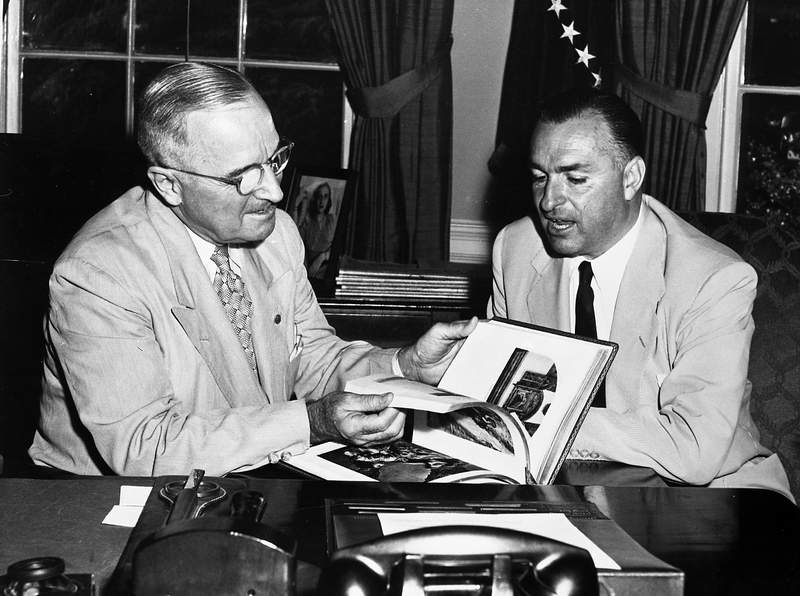
Types of Presidential Collections
There are three types of Presidential Materials held by the National Archives. The law that applies to the materials depends on how the materials are defined and the year they were created.
Donated Historical Materials
Until the Reagan administration, materials created during the presidency, with the exception of Nixon, were considered the personal property of the President or his associates, and came to the National Archives as donated historical materials.
The Presidential collections from Hoover through Carter, excluding Nixon, are maintained by the Presidential libraries and governed by individual donor deeds of gift.
The acceptance of these collections is covered by the Presidential Libraries Act of 1955, and the National Archives observes any restrictions on access to these materials that have been set by the donors, and agreed to by the Archivist of the United States. As a result, some of the Presidential materials in the custody of the Presidential libraries may not currently be available for research. Staff at the individual Presidential libraries can advise researchers on the availability of particular collections.
Presidential Records
In 1978, Congress passed the Presidential Records Act (PRA), which changed the legal status of Presidential and Vice Presidential materials. Under the PRA, the official records of the President and his staff are owned by the United States, not by the President. The Archivist of the United States is required to take custody of these records when the President leaves office, and to maintain them in a Federal depository.
These records are eligible for access under the Freedom of Information Act (FOIA) five years after the President leaves office. The President may restrict access to specific kinds of information for up to 12 years after he leaves office, but after that point the records are reviewed for FOIA exemptions only. This legislation took effect on January 20, 1981, and the records of the Reagan administration were the first to be administered under this law.
Staff at the Ronald Reagan Presidential Library and Museum, the George H. W. Bush Presidential Library and Museum, the William J. Clinton Presidential Library and Museum, the George W. Bush Presidential Library, Barack H. Obama Presidential Library, and the Donald J. Trump Presidential Library can provide additional information regarding access to Presidential records in their collections. Staff at the libraries can provide additional information regarding access to Presidential records in their collections.
Presidential Historical Materials
Only the Nixon Presidential Historical Materials are governed by the Presidential Recordings and Materials Preservation Act (PRMPA) of 1974. This only applies to the Nixon Presidential Historical Materials and none of the other libraries.
The Nixon Presidential Materials Staff at the National Archives at College Park, MD is responsible for preserving these materials and preparing them for public access under the law. For information regarding the availability of these materials, researchers should contact the Nixon Staff directly.
The National Archives holds classified Presidential and Vice Presidential microfilm, textual records, and electronic records. The National Archives systematically declassifies these records. In addition to systematically declassifying records, the public may request access to specific classified records by filing a Mandatory Declassification Review (MDR) request under the provisions of Executive Order 13526. Learn more about requesting access to Presidential and Vice Presidential collections. For more specific information about records, please contact the Library or Office of interest.
Declassified Records
Classified Consolidation
In 2018, the National Archives decided to consolidate all of the classified holdings from within the Presidential Library system to the National Capital Region. NARA’s National Declassification Center will facilitate the declassification review of these records and their return to the Presidential Libraries as they are declassified. Contact the Presidential Library that maintains the records you are interested in to submit a declassification request.
Remote Archives Capture Project
In 1995, NARA worked with the Central Intelligence Agency (CIA) and the intelligence and classifying community to develop a cooperative interagency plan called the Remote Archive Capture (RAC) project. The purpose was to digitize all classified Presidential records so that the scanned images could be brought to Washington, D.C for a declassification review by the equity-holding agencies. The RAC project declassified papers from the Truman, Eisenhower, Kennedy, Johnson, Nixon, Ford, Carter, and Reagan Presidential Libraries. Equity-holding agencies reviewed approximately 4 million pages as part of the RAC project. This program was replaced with the classified consolidation program in 2018. Contact the Presidential Library that maintains the records you are interested in to access the records declassified during the RAC project.
See Also:
Accessing the Presidential and Vice Presidential Collections
